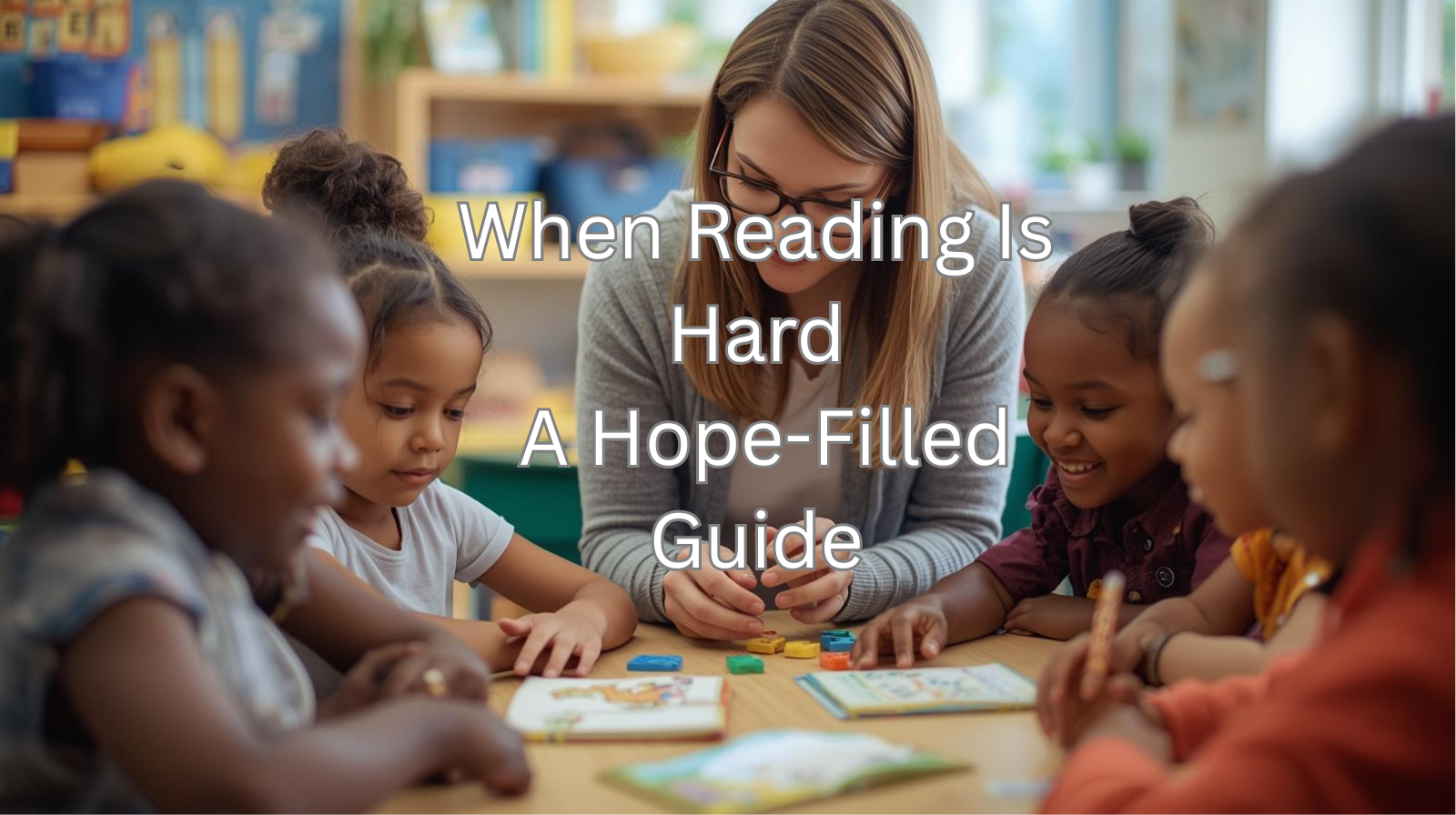
When Reading Is Hard: A Hope-Filled Guide for Parents and Schools
If your child or your students are struggling to read, maybe you have tried everything and nothing seems to stick. Please hear this first: you are not alone, and you are not failing. Reading challenges, including dyslexia, are common and solvable with the right approach. We can lead with courage and compassion, and we can insist on methods that work.
What actually helps most readers who struggle, including those with dyslexia
The strongest evidence points to Structured Literacy. Teach the building blocks of reading explicitly, in a clear sequence, with lots of guided practice. That means phonemic awareness, phonics, syllable types, morphology like prefixes and suffixes and roots, fluency, vocabulary, and comprehension strategies, all taught directly and cumulatively.
(International Dyslexia Association overview: https://dyslexiaida.org/what-is-structured-literacy/)
For classroom and small-group instruction, the What Works Clearinghouse recommends explicit teaching of foundational skills in K to 3, practice with decodable text, regular feedback during oral reading, and direct instruction in language and vocabulary. For grades 4 to 9, continue explicit word study including morphology, purposeful fluency practice, and strategy instruction for comprehension on grade-level texts.
- K–3 practice guide: https://ies.ed.gov/ncee/wwc/practiceguide/21 or PDF: https://ies.ed.gov/ncee/wwc/Docs/practiceGuide/wwc_foundationalreading_040717.pdf
- Grades 4–9 practice guide: https://ies.ed.gov/ncee/wwc/practiceguide/29 or PDF: https://ies.ed.gov/ncee/wwc/Docs/PracticeGuide/WWC-practice-guide-reading-intervention-full-text.pdf
Courage moment: It is okay to ask, “Can you show me the scope and sequence and how you will track progress?” Advocacy is love in action.
How parents can choose a tutor, and how schools can staff Tier 2 and Tier 3
Look for recognized certifications with supervised practice, not just “OG-based” (Orton-Gillingham). Ask for proof of coursework and certifications.
- CERI and IDA certifications. Structured Literacy Classroom Teacher, Structured Literacy Dyslexia Interventionist, and Structured Literacy Dyslexia Specialist.
(IDA certification page: https://dyslexiaida.org/certification/ and CERI certifications: https://effectivereading.org/ceri-certifications/) - Orton-Gillingham Academy. Classroom Educator, Associate, Certified, and Fellow, each with required coursework and practicum.
(Associate: https://www.ortonacademy.org/training-certification/associate-level/ and Certified: https://www.ortonacademy.org/training-certification/certified-level/ and Fellow: https://www.ortonacademy.org/training-certification/fellow-level/) - Wilson Reading System. Level I and Level II certifications with practicum and observations. Level I aligns to Wilson Dyslexia Practitioner and Level II aligns to Wilson Dyslexia Therapist.
(Overview: https://www.wilsonlanguage.com/professional-learning/wilson-reading-system-certifications/ and Level I: https://www.wilsonlanguage.com/professional-learning/wilson-reading-system-certifications/wrs-level-i-certification/ and Level II: https://www.wilsonlanguage.com/professional-learning/wilson-reading-system-certifications/wrs-level-ii-certification/ and credentials page: https://www.wilsonlanguage.com/professional-learning/wilson-professional-credentials/) - ALTA. CALP and CALT credentials for multisensory structured language therapy.
(CALP: https://www.altaread.org/about/what-is-calp/ and CALT: https://www.altaread.org/about/what-is-calt/ and ALTA membership info: https://www.altaread.org/join-alta/)
What to ask any provider: What certification do you hold? What does a typical lesson include? How often will you monitor progress and share data? Ask to see sample progress graphs and a written plan.
What Tier 2 and Tier 3 should look like
Interventions work best when they are small group or one to one, frequent, and long enough to matter, then adjusted based on data.
- Design intensity thoughtfully. Use the National Center on Intensive Intervention’s Taxonomy of Intervention Intensity to turn the dials on dosage, group size, explicitness, alignment with core, attention to transfer, and more.
- Progress monitoring. Check growth weekly or every other week using quick curriculum-based measures. Then change instruction based on the data.
- IRIS Center module: https://iris.peabody.vanderbilt.edu/module/pmr/
- CBM explainer page: https://iris.peabody.vanderbilt.edu/module/pmr/cresource/q1/p02/
- DBI progress monitoring page: https://iris.peabody.vanderbilt.edu/module/dbi2/cresource/q2/p03/)
- Choosing screeners and monitors. Use the NCII Tools Charts to review technical quality before you pick an assessment.
- Screening chart: https://charts.intensiveintervention.org/ascreening
- Overview: https://intensiveintervention.org/tools-charts/overview)
Compassion with boundaries: Families and teachers deserve clarity. Ask the school to show the intervention schedule, the group size, and the progress graph. If something is not moving, we change the plan, not the child’s potential.
Screening and identification
Strong systems screen all students in K to 2 for risk in phonemic awareness, letter-sound knowledge, decoding and word reading, and fluency. Many teams include Rapid Automatized Naming as part of a fuller look at reading risk.
- IDA Universal Screening K–2 fact sheet: https://dyslexiaida.org/universal-screening-k-2-reading/
For states and districts building policies, look for up-to-date state guidance and approved screeners as an example of how to organize the work.
- Example, California approved list: https://www.cde.ca.gov/nr/ne/yr24/yr24rel53.asp)
Accommodations while instruction builds skill
Alongside instruction, students with dyslexia often need accommodations that give access while we strengthen skills. Examples include extended time, text-to-speech, audiobooks for content areas, reduced copying, and options to show knowledge without heavy decoding. Accommodations change how a student accesses learning, not what the student is expected to learn.
- IDA accommodations page: https://dyslexiaida.org/accommodations-for-students-with-dyslexia/
- Printable example checklist: https://ia.dyslexiaida.org/wp-content/uploads/sites/37/2016/03/504-accomodations-sample.pdf)
For the heart
If you are a parent, exhale. You do not have to fix everything today. Pick one step. Schedule a meeting, ask about Structured Literacy, or interview a certified tutor. Your advocacy is brave, and it matters.
If you are an educator, you are allowed to learn out loud. It is strength, not weakness, to say, “Let us adopt a clearer scope and sequence, decodable text, and weekly progress checks,” and then do it together. You are also allowed to ask for training. That is professional courage.
Quick next steps you can act on this week
- Parents. Ask your school about its screening plan and intervention minutes. Look for tutors with CERI, Orton-Gillingham Academy, Wilson, or ALTA credentials.
- Schools. Align Tier 2 and Tier 3 with What Works Clearinghouse guidance. Use NCII’s Taxonomy to intensify. Set a weekly or biweekly progress-monitoring calendar and use the NCII Tools Charts to choose measures.
- Everyone. Keep the faith. Growth graphs can start slowly, then bend. Celebrate small wins. They compound.
A note of hope
I am dyslexic. I earned multiple degrees, including a doctorate. I’ve held multiple leadership roles, write blogs, and now books. None of that happened in spite of dyslexia. It happened because patient teachers, explicit instruction, and steady practice helped me learn how my brain learns. If your child is struggling, please hold onto this truth. Struggle is not a verdict. It is a beginning. With the right teaching and the right supports, readers grow. Your child can thrive in school and in life. You are not alone, and you do not have to do this by yourself. We will take the next right step together.

.png?width=1000&height=199&name=SG-Logo3-Transparent-1000x199px%20(1).png)

.jpg?width=100&height=100&name=elementary%20class%20transition%20(1).jpg)


